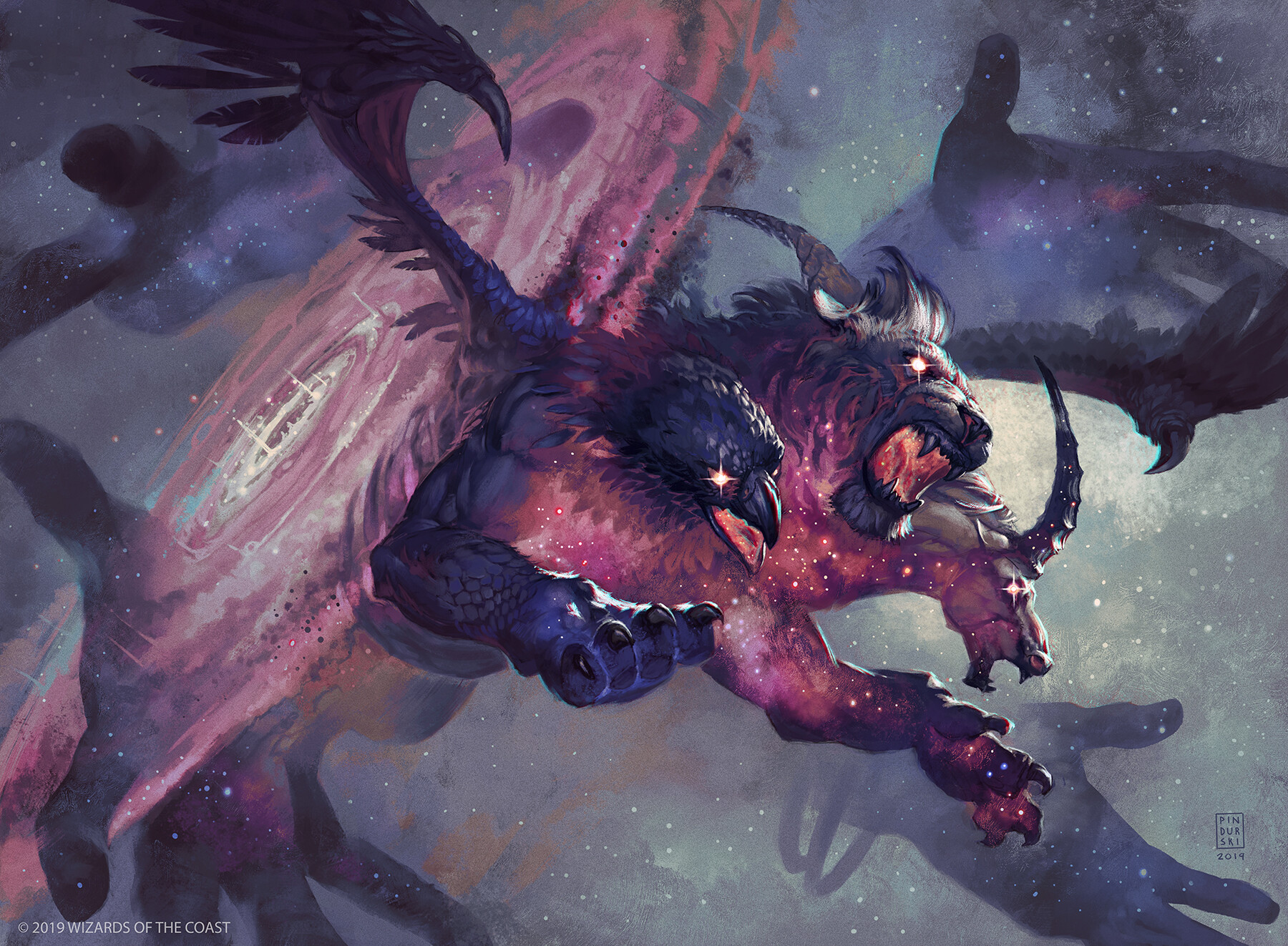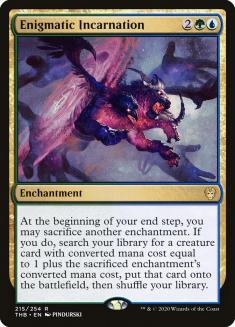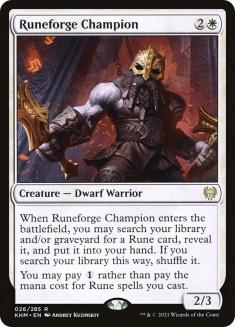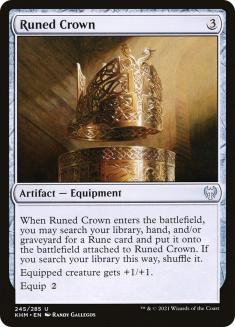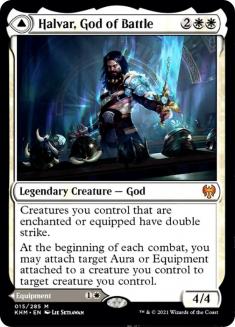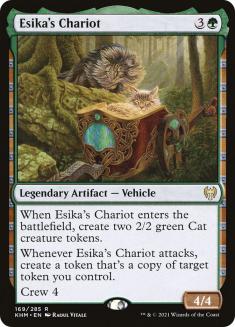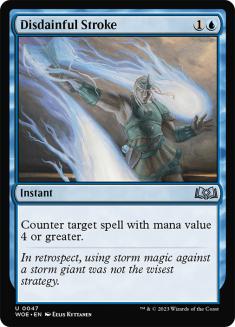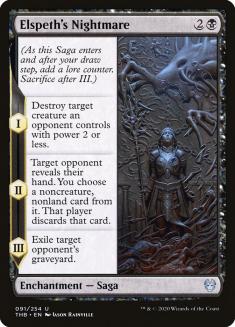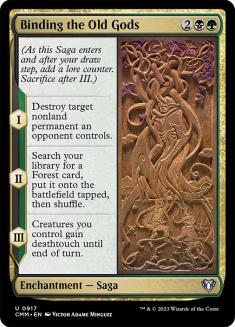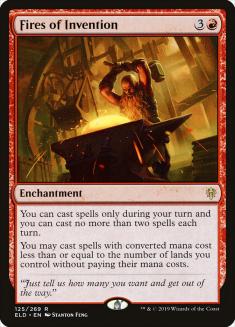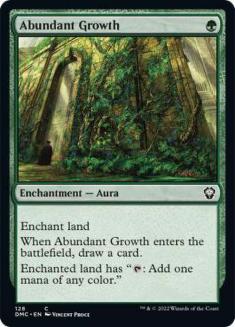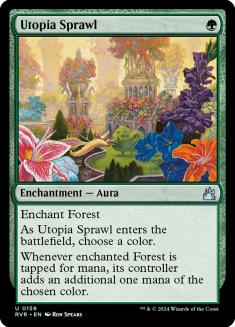Shortly before Uro’s departure from competitive Magic, when Modern looked like an absolute mess, I saw a Tweet about a delightful deck someone had managed to earn a trophy in a League with.
When I shared this deck, someone responded that they were porting it over to Historic, and then I started wondering about it in other formats. Before long, I heard that it was getting results in Pioneer as well.
What about Standard? Does Standard have enough tools to take advantage of Enigmatic Incarnation? Before we start looking into that, I want to lay some ground rules. Fundamental understandings that we need to have going into figuring out what Enigmatic Incarnation decks should look like.
First of all, it’s possible to build these decks without Yorion, but I don’t think it’s correct to do so. You give up a lot of flexibility in your bullets, run out of things to find after a few turns of Enigmatic Incarnation more often, and most importantly, because you want cantrips to sacrifice, Yorion itself is a very strong companion in these decks.
Given that we have Yorion as a companion, not Enigmatic Incarnation, we have to build the deck to function under the assumption that we won’t always draw Enigmatic Incarnation. That means you want every card to stand on its own merits when you draw it (or as close to that as possible), so minimize dedicated bullets.
Similarly, it’s risky to build in a lot of combos — the list in the Tweet above, for example, features Heliod, Sun-Crowned and Spike Feeder, which looks great on paper, since it’s often a game-winning combo that you can easily set up with Enigmatic Incarnation, but in practice, it’s not worth including these cards because neither has any real utility outside of this combo and they’ll show up too often when they do nothing. You’re very likely to win a game where you get to trigger Enigmatic Incarnation multiple times, especially when you have so much time that you can use it once on something with no immediate impact, so it’s just not worth including such narrow cards.
Finally, because creatures that you find enter the battlefield at the end of your turn, your opponent gets to interact with them before you can use them. This means creatures with entesr-the-battlefield triggers are at a particular premium. Rule-setting lock pieces also play well, but Setessan Champion, for example, has been disappointing for me so far.
With all that understood, let’s get into some decks.
Standard
Let’s start with Standard, where I’m exploring a few different approaches.
Creatures (18)
- 1 Archon of Sun's Grace
- 1 Dryad of the Ilysian Grove
- 3 Yorion, Sky Nomad
- 1 Barrin, Tolarian Archmage
- 4 Skyclave Apparition
- 1 Glasspool Mimic
- 3 Halvar, God of Battle
- 4 Runeforge Champion
Lands (32)
Spells (30)
- 3 Glass Casket
- 4 Omen of the Sea
- 4 Enigmatic Incarnation
- 4 Shark Typhoon
- 1 Emeria's Call
- 2 Esika's Chariot
- 1 Rune of Flight
- 4 Runed Crown
- 2 Rune of Sustenance
- 1 Rune of Speed
- 4 Rune of Might
Sideboard

The reason to play Bant is simple. Enigmatic Incarnation is a Simic card and Skyclave Apparition is the best three-mana creature to tutor for. Given that the cantrip enchantments in Standard cost two mana, you want to search for three-mana creatures.
The next step is Runeforge Champion.
Runeforge Champion is a much better card than I thought it was when I first read it, but pairing it with Enigmatic Incarnation creates an amazing engine. If you have any two-mana enchantment, you can search for Runeforge Champion and get a Rune. On the following turn you can cast the Rune and then sacrifice it to get a Runeforge Champion, which can return the Rune from your graveyard to your hand. When all is said and done, you essentially get to make a 2/3 creature and draw a card every turn with your Enigmatic Incarnation, which is about twice as good as a four-mana planeswalker and much harder to kill.
Once we have Runeforge Champion and a bunch of Runes, the next step is Runed Crown. Runed Crown is a three-mana cantrip, which is a lot worse than a two-mana cantrip, and it’s an artifact, which means it doesn’t work well with Enigmatic Incarnation – except that because it puts an enchantment onto the battlefield, it does just as much to make sure we have a two-mana enchantment as adding another two-mana enchantment would, and it’s incredible to blink with Yorion because you get to blink both the Crown and the Rune. Now you’re drawing two cards, and each additional time you blink it, you draw one more card than you did the previous time.
So we have an artifact that draws cards, but the fact that it’s also an Equipment is not a small piece of its power. This deck assembles a lot of Runes, even while you’re sacrificing enchantments, and if you put all of those on Runed Crown, suddenly you find yourself with a massively upgraded Loxodon Warhammer.
This deck doesn’t really want to cast Runes on creatures because it wants the Runes on the battlefield to take advantage of using Enigmatic Incarnation or Yorion. This means most of the time, Runes enchant lands, but Equipment offers a more secure location to hold your Runes that actually pays dividends.
Enter Halvar, God of Battle. I wanted more Equipment so that I could make my Runes better, and it turns out Sword of the Realms is incredible when you can put some Runes on it and equip a creature with a good enters-the-battlefield ability. If Sword of the Realms gives +3/+1, trample, vigilance, and lifelink, and you equip a Skyclave Apparition or Runeforge Champion, such that if your creature dies you just get another Rune or exile another one of their cards, what’s your opponent supposed to do? Also, when you have other Equipment in your deck, Halvar itself isn’t half bad.
My first draft of this deck also included Omen of the Sun to make sure I had creatures to equip, but I had too many things that cost three mana, so I realized I’d be better-served by upgrading to Esika’s Chariot, a card that’s probably more than one mana more impactful than Omen of the Sun.
The big weakness of a midrange deck that’s investing a lot of resources in incrementally growing its battlefield is that Ugin, the Spirit Dragon can invalidate a lot of work, usually singlehandedly beating you. The great thing about playing blue in a deck like this is that you can fill your sideboard with counterspells, as I’ve done, and with so much card drawing, you can be more than ready by the time your opponent is trying to resolve an Ugin.
Shark Typhoon feels a little weird in the maindeck here, but it’s not bad and it plays really well with the somewhat transformative sideboard. Giant Killer is the removal spell of choice because it’s incredible with Sword of the Realms.
However, this isn’t the only way to approach Enigmatic Incarnation in Standard.
Creatures (13)
- 1 Scavenging Ooze
- 1 Kenrith, the Returned King
- 1 Klothys, God of Destiny
- 1 Polukranos, Unchained
- 1 Acolyte of Affliction
- 1 Lurrus of the Dream-Den
- 1 Yorion, Sky Nomad
- 2 Llanowar Visionary
- 1 Elder Gargaroth
- 1 Nighthawk Scavenger
- 2 Glasspool Mimic
Lands (31)
Spells (36)

While it’s best practice with Enigmatic Incarnation to alternate between casting costs full of enchantments and casting costs full of creatures (for example, every two-mana permanent is an enchantment, every three-mana permanent is a creature, every four-mana permanent is an enchantment, and every five-mana permanent is a creature, because this maximizes your consistency, flexibility, and smoothness of your curve), it’s not strictly required that you build around Enigmatic Incarnation this way. As it happens, there are both creatures and enchantments across the curve in Sultai that play well in this shell and this deck tries to accommodate all of that.
Assuming you cast Enigmatic Incarnation on time, it plays extremely well with Sagas, where you can get the first two chapters and then sacrifice them for something else, especially Sagas where the last chapter is the least impactful, like Elspeth’s Nightmare and Binding the Old Gods.
By playing enchantments that are also interactive spells in the form of these Sagas, this deck manages to find enough room for a sufficient density of enchantments to allow Enigmatic Incarnation to function while fundamentally playing as an “answers deck” in a way the previous deck certainly doesn’t.
As we’ve seen with four- and five-mana planeswalkers historically, these kinds of cards typically play best when supported by answers because answers make the game last longer and the incremental advantage they generate can win these longer games. Enigmatic Incarnation works the same way. As long as we can answer the opponent’s threats, we can trust that Enigmatic Incarnation will eventually bring us to a victory, so this deck is built to do that.
The creatures we can find for three mana are much weaker than the creatures in the Bant deck, but turning a Path to the World Tree into a Llanowar Visionary to draw a card is still a worthwhile play. And because we’re playing black, we get to include these interactive Sagas.
Speaking of Path to the World Tree, I was excited to play this with Yorion since I first saw it, but I found that in most Yorion decks, I wasn’t interested in the ability to spend seven mana to activate Path to the World Tree because I had so many other things to do with my mana. This is because I tend to build Yorion decks to create large battlefields rather than small battlefields.
Path to the World Tree is much better in small games where players trade resources as much as possible. As such, this is by far the best shell I’ve found for Path to the World Tree, even if it’s not really built to have the mana to activate it very consistently, since you expect to sacrifice it to Enigmatic Incarnation most of the time.
Historic
In Historic, I get better lands and access to Urban Utopia, so I can try to have the best of both worlds.
Creatures (15)
- 1 Ravenous Chupacabra
- 1 Knight of Autumn
- 1 Deputy of Detention
- 1 Kenrith, the Returned King
- 1 Klothys, God of Destiny
- 1 Archon of Sun's Grace
- 2 Acolyte of Affliction
- 1 Yorion, Sky Nomad
- 1 Llanowar Visionary
- 4 Skyclave Apparition
- 1 Glasspool Mimic
Lands (33)
Spells (32)

This deck looks a lot like a Doom Foretold deck but it splashes Enigmatic Incarnation instead of playing the Orzhov enchantment. Both enchantments allow you to sacrifice enchantments that did something when they entered the battlefield and are essentially left hanging out, but Enigmatic Incarnation allows you to do so in a way that advances your battlefield, which is more synergistic with Yorion.
This deck minimizes blue to pair Skyclave Apparition with the black removal like the Sultai deck in Standard was using, but with the Historic additions of Oath of Kaya and Trial of Ambition.
Since this deck has so much removal maindeck, it can struggle with control decks where its cards can’t be actively deployed. To make up for that, the sideboard includes Destiny Spinner and Treacherous Blessing to improve its ability to grind against opponents who aren’t offering up creatures for you to destroy.
Pioneer
So what happens when we port this over to the Pioneer card pool?
Creatures (19)
- 1 Izzet Staticaster
- 1 Eidolon of Blossoms
- 1 Eidolon of Rhetoric
- 1 The Scarab God
- 1 Knight of Autumn
- 1 Deputy of Detention
- 1 Tolsimir, Friend to Wolves
- 1 Niv-Mizzet Reborn
- 1 Kenrith, the Returned King
- 1 Klothys, God of Destiny
- 1 Kunoros, Hound of Athreos
- 1 Destiny Spinner
- 1 Yorion, Sky Nomad
- 1 Omnath, Locus of Creation
- 4 Skyclave Apparition
- 1 Glasspool Mimic
Lands (30)
Spells (31)

The biggest difference between this deck and its Historic counterpart is the real addition of red. Fires of Invention and Chained to the Rocks aren’t legal in Historic, but they are in Pioneer. The addition of red mana gives the deck much cheaper removal and Fires of Invention offers a kind of explosiveness that isn’t available in Historic, which leads the Pioneer deck to include move five-mana creatures. If Fires of Invention isn’t good with your hand, you can cast it and use it to cast Enigmatic Incarnation and immediately sacrifice the Fires to get a five-mana creature, allowing you to essentially cast something like Niv-Mizzet Reborn for four mana while getting an Enigmatic Incarnation onto the battlefield for free.
Izzet Staticaster is another nice bullet that isn’t available in Historic, but most of the rest of the cards are very similar, just shuffled around a bit.
Modern
Modern is a whole different animal because you gain access to strong one-mana enchantments in Utopia Sprawl and Abundant Growth. These cards mean that you want to include two-mana creatures, and as a result, we see the entire curve compact in a way you’d expect from an older format.
Creatures (24)
- 3 Birds of Paradise
- 1 Auriok Champion
- 1 Meddling Mage
- 1 Magus of the Moon
- 1 Spellskite
- 1 Scavenging Ooze
- 1 Phantasmal Image
- 1 Brain Maggot
- 1 Reflector Mage
- 2 Renegade Rallier
- 1 Knight of Autumn
- 1 Deputy of Detention
- 1 Ice-Fang Coatl
- 1 Seasoned Pyromancer
- 1 Plague Engineer
- 1 Charming Prince
- 1 Lurrus of the Dream-Den
- 3 Skyclave Apparition
- 1 Glasspool Mimic
Planeswalkers (3)
Lands (29)
Spells (24)

While Renegade Rallier is legal in Pioneer and Historic, without fetchlands, it’s too bad to draw it, but in Modern, it’s an excellent tool.
This deck is very much built on the principle of not playing bad cards. Yes, in isolation, it has a somewhat random assortment of creatures, but most of them are generally reasonable creatures to draw. Spreading Seas is slightly below rate, but not an embarrassing Modern card, so the main cost is that you have to play Omen of the Sea and Omen of the Forge to get the full payoff of Enigmatic Incarnation.
This deck is something like Birthing Pod, except instead of playing creatures that chain into some kind of infinite combo, this deck essentially just searches up hatebears. Against decks that aren’t weak against some sort of rule-setting creature, you’re forced to play more of a value game, but that’s also a game you’re well-prepared to play.
The list presented here is similar to versions that have been successful so far, but there’s still a lot of room to explore in this archetype. This deck could include Stoneforge Mystic, either a single copy or multiples, and an Equipment or two. It could include Ranger-Captain of Eos as a way to search for one-mana creatures if you wanted to include those in your toolbox, and any unique two- or three-mana creature is on the table. Eternal Witness? Cosima, God of the Voyage? Flickerwisp? The pool of possibilities in Modern is very large.
I think Abundant Growth and Utopia Sprawl are such large upgrades for this deck that I suspect the Modern version is the strongest relative to its format, but I think all of these decks offer an interesting play pattern that fans of toolbox decks have likely been missing since the days of Birthing Pod.

